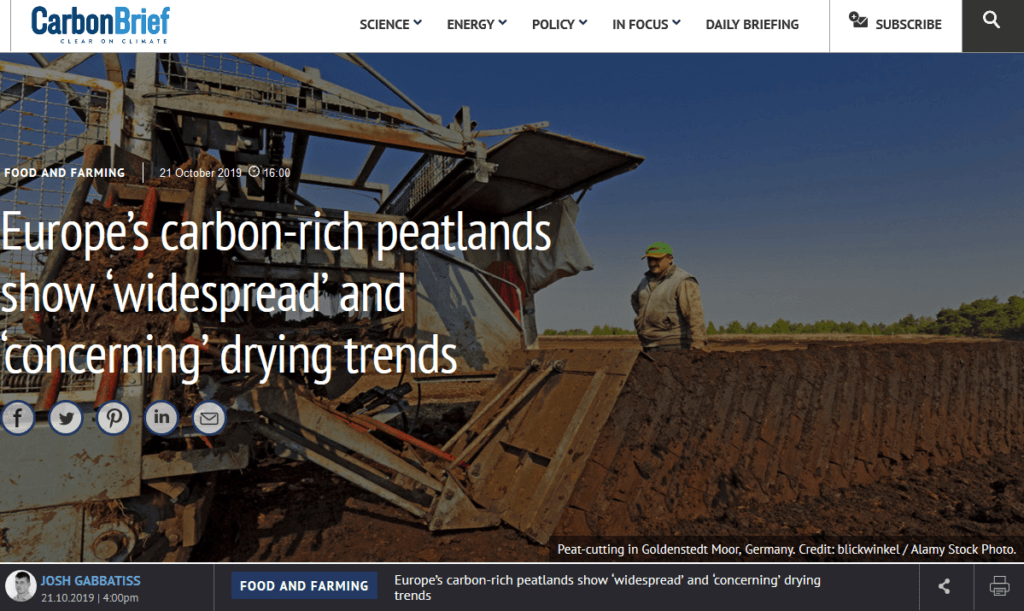
Europe’s peatlands are drying out – due to a combination of factors including human actions.
And recent estimates of carbon stored in peatlands are twice as high as previous ones.
Here is an accessible and useful account of these two papers with interviews with a range of scientists. Altogether peatlands are even more important than previously thought for carbon storage – but all is not well, largely due to human assaults on peatlands.
I was struck by some quotes from the article above;
[registration_form]Despite only covering around 3% of the Earth’s surface, peatlands contain roughly a fifth of its soil carbon. In Europe, these ecosystems store five times more CO2 than forests.
Cutting, drainage, burning, agriculture, afforestation. All driven by need for peat as a resource or for land-use practices not in line with keeping healthy peatlands.
The results [drying out] were most severe for peatlands across Great Britain and Ireland.
https://www.carbonbrief.org/europes-carbon-rich-peatlands-show-widespread-and-concerning-drying-trends?utm_campaign=Carbon%20Brief%20Daily%20Briefing&utm_medium=email&utm_source=Revue%20newsletter
I’m currently reading Dave Goulson’s The Garden Jungle. He is very angry with the soft targets that British horticulture is setting itself for the removal of peat from growing media. I’ve been peat-free in my garden for years but find it difficult to get sufficient information on commercial compost bags to ensure they don’t contain peat.
It’s outrageous. It is not as though this is a problem that has only recently come to light. The entire horticulture industry should have gone peat free years ago.
“should have”
Yes – but the crapulous performance of peat-free composts has held it back. At the retail customer level you are likely to lose a significant proportion of sown seed using p-fc. I have had two years of useless outdoor tomatoes while using highly-expensive bulrush compost. I will quietly lose what’s left over as mulch around the gaff for the sake of Peace and Harmony.
A clear problem is the hiding of waste MDF in p-fc, in addition to all the other junk. It’s the circular economy, innit.
Lyn – make sure you stick with peat-free compost or make your own or get a wormery so you can use the liquid.
Our local council creates ‘soil conditioners’ which they sell. This terrible product is made from the bits of food chucked in the bin. It goes to the processing plant where magnets extract the metals from the waste, prongs pull out plastic bags and the ‘food’ is extracted by putting the waste through a sort of huge sieve which rolls around and liquids and small items fall through the sieves. What goes through is chopped up and then added to the wonderful green garden waste collected from householders so that it has nutrients and the ‘bad’ effects aren’t so bad. So what are those negative aspects? You can’t separate food and liquids from cleaning fluids, diesels, medication etc etc. You can’t get rid of tiny bits of plastic, small batteries or smashed glass shards etc. It all gets mixed up with the mush. To prevent the shards of glass causing potential injuries, the mix is then ground up until it is powder-like. That’s partly why they have to add it to genuine compost created from household waste to give it structure and some nutrients.
Of course if councils had separate kitchen and garden waste collection systems then all this technological ‘fix’ to extract food from waste to avoid landfill tax wouldn’t be needed and quality products could be created which councils could rightly be proud of.
We make garden compost and also have a separate leaf cage. I was pleased to find that Dave Goulson and I use the same way of making seed compost – leaf mould plus sharp sand. I’ve used it successfully to raise wildflower plants for local nature reserves.
Very true, Lyn. And finding out what is in the pot with bought plants is even harder.
So well done RSPB Forsinard and Flows to the Future
And still rotational burning of moorland continues. Last week burning at Strines, Peak District had some burns within the deep peat layer and some just outside, though clearly all on peat soil. Where is the legislation to ban burning blanket bog? And its obvious this needs to be extended to stop burning on all peat, including areas of less than 40cm depth.
Bob – I agree with you. DEFRA seems to have ceased all action on this front – scandalous!
Recently: https://scottishwildlifetrust.org.uk/news/plans-approved-large-scale-peat-extraction-near-penicuik/#.XZ5QVs4i71d.twitter